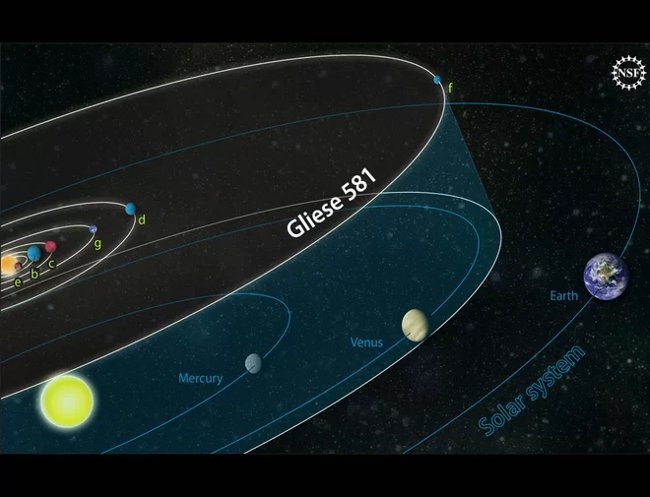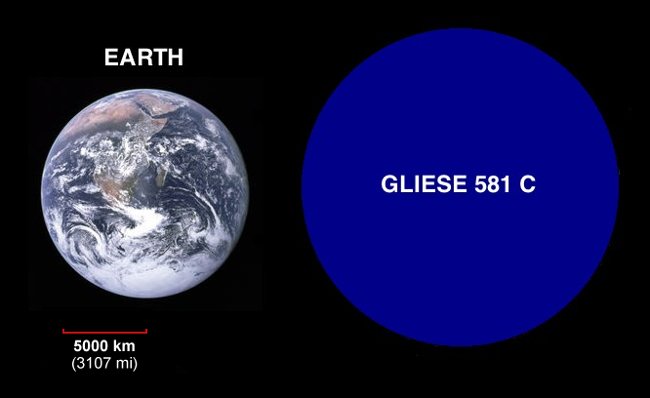Learn about extraterrestrial super-Earth - Gliese 581c
Gliese 581 is a red dwarf with the M3V spectrum, located 20.3 light-years away from Earth in the constellation Scorpio. Astronomers estimate its mass by about a third of the Sun's mass and 87th in the list of star systems closest to the Sun. Observations and measurements show that the star has at least six planets orbiting it: Gliese 581e, Gliese 581b, Gliese 581c, Gliese 581g, Gliese 581d and Gliese 581f ( in order from the star ). In particular, the planet Gliese 581g is said to be near the middle of the star's habitable zone.

This Gliese 581 star system attracted the attention of astronomers after Gliese 581c , a low-mass alien planet was found near the star's " survival area " in April 2007. Scientists have shown that under climate models on rocky planets, Gliese 581c has a climate very similar to Venus and may not be a habitable planet. The next planet to be discovered is Gliese 581d, which has some similar characteristics to Mars and is located right at the edge ( inside or outside ) of the habitable zone ( depending on the nature of the greenhouse effect on the planet. ). The discovery of the next exoplanet is Gliese 581e - the planet with the closest mass to Earth's mass, announced by astronomers in April 2009. In September 2010, attention Focus on this star system when it was announced that Gliese 581g has been discovered, with the most known Earth-like planet today, when it is possible to survive life on the planet. this planet.
 The star system Gliese 581 is superimposed on our solar system to easily compare the orbital distance.Photo source: National Science Foundation / Zina Deretsky.
The star system Gliese 581 is superimposed on our solar system to easily compare the orbital distance.Photo source: National Science Foundation / Zina Deretsky.
Gliese 581c is a super-Earth planet discovered in 2007. Gliese 581c is in the star system Gliese 581, about 20 light-years from Earth, relatively close to our planet ( in terms of celestial bodies ). While the original study suggested that Gliese 581c might exist as a liquid on its surface because it is in the star's " livable region ", many recent studies suggest it could has an environment similar to Venus.
Discover
Gliese 581c's existence was announced in 2007 in the journal Astronomy and Astrophysics. The article was provided by Stephane Udry, an astronomer at the Geneva Observatory. Gliese 581c is one of the two super-Earth planets his team has found, both located on the boundary of the star's " survival zone ".
Gliese 581c is found using the radial velocity method, which means that it is detected through drag on the host star. The detector is a HARPS spectrum on a 3.6-meter telescope managed by the Southern European Observatory in Chile. ( HARPS is one of the planetary search tools available for astronomers today )
At that time, researchers said Gliese 581c is " the most known planet of our Earth planet " because it is only five times the mass of Earth. ( Searches later found more planets closer to Earth's mass. )
While Gliese 581c is classified as Earth, the researchers warn that the actual conditions on the planet may be very different from ours. For example, surface temperature will depend on the composition and thickness of the atmosphere. The atmosphere also determines the amount of light reflected off the planet and the intensity of the greenhouse effect.

Gliese 581c's master, known as Gliese 581, is a M-dwarf star. It is cooler than the Sun, meaning that its habitat is closer to our Solar System. M-type dwarfs are " preferred " for planet searches because they are dimmer, which means that planets passing through the star will be easier to see. There is a relatively small size between the planet and the star, making their gravitational effect more obvious.
Characteristics and living areas
For many years of research, scientists have learned that Gliese 581 has different opinions about how many planets are there; for example, discover Gliese 581g in 2010 for example. The signs of the planet do not appear in independent searches, and today most astronomers in the field assume that the planet does not exist.
Direct measurements cannot be made which makes it difficult to determine Gliese 581c's radius when viewed from Earth, because the planet does not pass through its main star. The planet is also unable to see directly through the surface of the star, so astronomers can only learn the characteristics of Gliese 581c's influence on other planets and stars. The radius will determine problems such as whether the planet is closer to Earth-like planets ( with a smaller atmosphere ) or closer to Neptune-like planets ( with a thicker atmosphere ).
Gliese 581c takes about 13 days to move around the host. ( On the other hand, Mercury's orbit around the Sun is much larger than it takes about 88 days .) Because Gliese 581c is very close to its host star, it is predicted that the planet is locked in tides. This means that when it orbits the one-sided orbit of the planet, it always points towards the star. This phenomenon is common among the moons of Jupiter and Saturn in our solar system.
If a planet is locked to a tide, it means that one side ( face facing the star ) is usually warmer than the other (the face is not facing the star ). Any consideration of the area where life can exist must pay attention to this. A certain example of a life-existent planet that we know - our planet Earth - has a normal day-night cycle in most areas of the planet, except for the poles. Over billions of years, life forms have to adapt to this cycle. It is not clear how life will exist in an area that is only daytime or only at night, but studies are still underway.
The next report of the journal Astronomy and Astrophysics in 2007 was researched by Werner von Bloh at the Potsdam Institute for Climate Impact Research, which suggested that Gliese 581c is too hot to support life. because it is close to its host star. This means that the planet can have more than one Venus-like environment, with extremely hot surfaces and runaway greenhouse effect in a dense atmosphere. This was confirmed in a 2011 study on the magazine Astronomy and Astrophysics (Astronomy and Astrophysics) by Y. Hu, who is working with the Beijing University laboratory, for research. Save the climate and ocean atmosphere.
Although Gliese 581c has not been discussed much in scientific literature in recent years, astronomers are studying more to improve the model of planets close to their parent stars. For example, the 2013 paper was published in Nature, in which a team run by Jeremy Leconte directs a survey of conditions.
The runaway greenhouse effect occurs on Earth-like planets. This series of research is gaining more attention after the discovery of Proxima Centuari b, a life-capable planet just 4 light-years from Earth in 2016.
Refer to some more articles:
- 6 strange facts about Proxima Centauri b - "Second Earth" you may not know
- Science test: Potatoes can be grown on Mars
- SpaceX reversed the plan to launch missiles on Mars by 2020
Having fun!
You should read it
- Discovering another 'super Earth' can appear to live only 21 light-years away
- 7 alien planet is more exotic than science fiction movies
- The discovery of the 'Second Earth' can exist only 4.2 light-years away from Earth
- Discover incredible facts about our cosmic planet
- NASA will launch new space telescope into space to find 'second earth'
- 'Planet Hunters' are looking for signs of extraterrestrial life around nearby stars
 Why NASA never wants to send people to Venus
Why NASA never wants to send people to Venus Will there be unmanned aircraft approaching the Mars atmosphere in the future?
Will there be unmanned aircraft approaching the Mars atmosphere in the future? New discovery of life on planet GJ 1132b, 'Super Earth' is 39 light-years away
New discovery of life on planet GJ 1132b, 'Super Earth' is 39 light-years away Discover incredible facts about our cosmic planet
Discover incredible facts about our cosmic planet Maybe the Solar System 2.0 is not the 'cradle of nurturing life' as NASA hopes
Maybe the Solar System 2.0 is not the 'cradle of nurturing life' as NASA hopes NASA will reveal new discoveries about extraterrestrial ocean worlds tonight
NASA will reveal new discoveries about extraterrestrial ocean worlds tonight